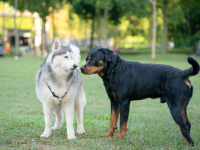Once you have the greeting basics down, it may be time to introduce your dog to other dogs. It's good to limit your first attempts to just meeting one new dog at a time in a neutral spot for both dogs. It can often be problematic for one to have a home field advantage over the other, or feel like they have to protect their domain/people from an intruder. The best scenario is outdoor, fully fenced, leashed, without other dogs or extra people beyond the dedicated handlers for each dog.
If you don't have access to a fenced area, then use what you have; a large garage, basement, or large outdoor area away from distractions (including no toys, treats, or anything else the dogs could fight over).
If you are in a situation where you are bringing a new dog into the family, let the new dog get comfortable with your home while the other dog is off on a stroll or joyride with a friend or family member. When ready, let the dogs meet in an open area of the house: not front door spaces, or anywhere they can compete for space and get cornered by the other dog.
As you complete the following steps, watch the dogs’ body language throughout and in the days after. When they meet new people, look for your doggie to display happy body language: tail wagging, full body wagging, ears back, and no hard/direct eye contact.
If you notice any of the following behavior from your dog, then it is time to give them a break.
- Tough Stares/Hard Eye Contact
- Tense Postures
- Ears Hard Forward
- Freezing in Place
- Lunging on Leash
- Growling
- Stiff. Raised, Fast Wagging
- Lowered/Tucked Tail
- Tries to Run Away
- Runs Back to You
A common mistake is allowing the dogs to meet face-to-face (nose-to-nose) while on their leashes, as both handlers are pulling back on tight leashes. This is an unnatural meeting position and leashes should remain loose. Unnecessarily tightening a leash can trigger an aggressive response from a dog. Should the situation become irredeemable, and things take a sudden turn for the worst, breaking up the dogs becomes necessary, and that's why the leash is there, as a failsafe.
If things go well and you wish to walk the two new canine companions together, then initial leash walks should have a buffer area between the two. Keep them far enough away that they are still aware of each other, but not close enough for them to reach the other
As they grow comfortable with each other during inevitable potty stops, let them move closer to each other on their leashes. If they pass all the tests up to this point, you can allow them to interact off-leash by returning to the enclosed area and allowing more sniffing.
Continually praise the dogs for their friendly actions. They are ready to play when they give each other that telltale bow: elbows on the ground, rear in the air, and a smile on their faces.
Just because they get through one phase okay, doesn’t mean they are going to move smoothly through each step. If you’re introducing a new dog to the house, make sure that each dog still gets alone time, has its own sleeping space, own toys, and so forth.
If you run into any problems that you can't seem to overcome with a little time and patience, then consult a professional.

 Call Us Today 864-901-3189
Call Us Today 864-901-3189
